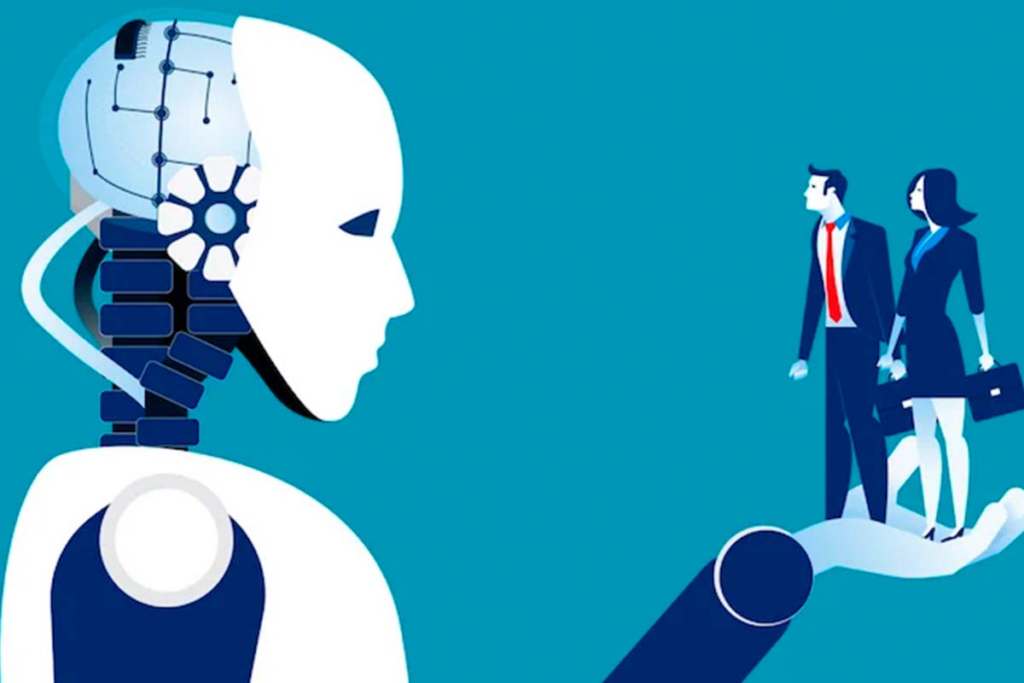The New Landscape of UX in the Age of AI

Nowadays, it is evident how artificial intelligence and UX design complement each other to create more intuitive, personalized, and efficient user experiences. Illustration of a robot holding a family in the palm of its hand
Artificial Intelligence has quickly captured the interest of the tech world due to its promising potential. Its ability to process and learn from vast amounts of data makes it an invaluable tool in the digital age.
This is why AI is increasingly implemented across various industries, thanks to its enormous potential to transform and enhance processes.
The Importance of the UX Role in Defining and Creating AI Products The tasks and challenges faced by UX design with the implementation of AI tools require a deep understanding of both emerging technology and the evolving needs of users.
Thanks to artificial intelligence, we have begun to change the way we interact with technology.
Gone are the days when it was normal to give devices instructions to perform a task; now, it is possible to simply indicate our goal for the device to carry it out.
This shift leads us to a new way of relating to machines, where the most important aspect is that we understand and express what we truly want.
“While artificial intelligence has made significant progress, it still needs to direct its focus toward users. The key lies in understanding how people use these technologies in practice when we design them,” says Jakob Nielsen.
Rather than focusing solely on visual aspects and current functions, UX designers must adopt a proactive vision, anticipating future needs in a constantly changing world.
The integration of AI into user experience presents a horizon full of long-term possibilities and challenges. Therefore, for successful implementation of AI-based solutions, it is crucial for UX designers to work closely with developers.
This collaboration must ensure that the solutions are not only technically feasible but also ethical, safe, and genuinely enrich the user’s interaction with technology. In this way, joint products that truly serve the users are built, anticipating their future needs in an evolving technological environment.
The User Experience (UX) of AI To properly design interfaces and systems based on AI, there are several principles and recommendations designers should keep in mind:
- Always start by understanding the user.
- Set expectations correctly and precisely.
- Communicate effectively how AI works.
- Ensure AI is reliable and can communicate its accuracy.
- Allow users to maintain control.
- Build trust over time.
- Help users learn and evolve with the platform.
- Ensure personalization is not excessive.
- Avoid collecting unnecessary user data.
- Analyze for biases in information delivery. Currently, various methodologies are combined to develop digital products centered on the user, such as the combination of Design Thinking, Lean Startup, and Agile allows for a solid structure.
However, with the integration of AI, questions and concerns also arise about how it is implemented and used.
This is where ethics come into play.
Why is Ethics Fundamental in AI? Ethics in AI refers to the set of principles, values, and standards that guide the use and development of artificial intelligence. Its primary purpose is to ensure that technology is used in a way that respects human rights, dignity, diversity, equity, and the common good.
In other words, this ethics aims to ensure AI is used responsibly, fairly, and safely.
This is why there are certain challenges in the field of AI, such as:
- Equity and Non-Discrimination: While AI can bring unprecedented benefits, there is a real risk of it reproducing existing biases and discriminations, so an ethical framework is needed to help prevent these technologies from reinforcing divisions, violating human rights, and fundamental freedoms of individuals.
- Privacy and Data Protection: With AI’s ability to collect and process vast amounts of information, concerns emerge about the privacy and security of personal and corporate data.
- Accountability and Human Oversight: As AI systems become more autonomous, the question of who is responsible for their actions arises. Human oversight remains essential, especially in areas where AI decisions can have serious repercussions.
- Transparency and Explainability: Ensuring that AI decision-making processes are transparent and understandable is crucial for building trust in these technologies.
- Employability: AI has the potential to change the employment landscape. Although it can automate certain jobs, it can also open doors to more creative and strategic roles.
Undoubtedly, the fusion of AI and user experience design is an emerging and exciting field, and as AI technologies continue to evolve, it is imperative that designers stay at the forefront, ensuring that solutions are humane, ethical, and truly useful.
“As experience designers, it is our social, ethical, and moral responsibility to understand AI as a complement that needs our critical eye to use and project the future as agents of change, and not to perpetuate biases, discrimination, or non-representativeness when using these tools. The human factor remains the most relevant in the creation of digital products for people,” comments Carolina Sepúlveda Robles, Partner and Director of Experience & UX at 2Brains.
As an organization, we understand the importance of an ethical approach towards AI, so we are committed to providing support and training to adapt
to these changes.
At the same time, we encourage our collaborators to use AI responsibly, protecting confidential information and always respecting intellectual property rights.
In this way, with the proper training and an ethical approach, we can ensure that we maximize the benefits of AI while minimizing its potential risks.